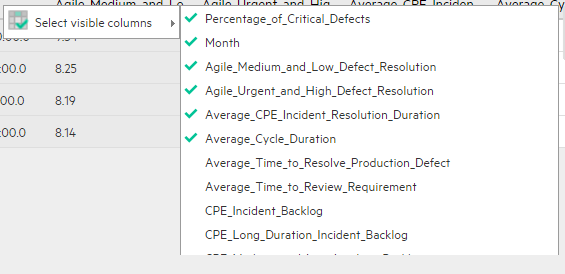Searching the Help
To search for information in the Help, type a word or phrase in the Search box. When you enter a group of words, OR is inferred. You can use Boolean operators to refine your search.
Results returned are case insensitive. However, results ranking takes case into account and assigns higher scores to case matches. Therefore, a search for "cats" followed by a search for "Cats" would return the same number of Help topics, but the order in which the topics are listed would be different.
| Search for | Example | Results |
|---|---|---|
| A single word | cat
|
Topics that contain the word "cat". You will also find its grammatical variations, such as "cats". |
|
A phrase. You can specify that the search results contain a specific phrase. |
"cat food" (quotation marks) |
Topics that contain the literal phrase "cat food" and all its grammatical variations. Without the quotation marks, the query is equivalent to specifying an OR operator, which finds topics with one of the individual words instead of the phrase. |
| Search for | Operator | Example |
|---|---|---|
|
Two or more words in the same topic |
|
|
| Either word in a topic |
|
|
| Topics that do not contain a specific word or phrase |
|
|
| Topics that contain one string and do not contain another | ^ (caret) |
cat ^ mouse
|
| A combination of search types | ( ) parentheses |
|
- End User - View and Analyze the Business Objectives
- Dashboard
- Change, On-the-fly, the Component Display Format
- Change, On-demand, the Periodicity Used in a Component Display
- Change, On-Demand, the Breakdown Display
- First Level Navigation (FLN) for an Objective, a KPI, or a Metric
- Explorer
- Explorer - Overview
- Explorer - Data Set
- Explorer - Goal Map
- Explorer - Forecast
- Explorer - What If
- Explorer - Annotations
The Data Set area in the Explorer tab is available only for KPIs, Metrics, KPI Breakdowns, and Metric Breakdowns. It provides the ability to drill down into the details of the formula used to calculate the KPI or Metric, to see the building blocks of the calculation results, and to analyze the data used for the calculation. The page provides the formula, the filter, and the display of the data.
Click the Explorer tab to access detailed information about all the Scorecards, Objectives, Perspectives, KPIs, KPI Breakdowns, Metric, Metric Breakdown, or Unassigned KPIs that are active in the Studio. In the EXPLORER tab, click the relevant item and click the Data Set button.
 Access Explorer to display detailed information about a selected KPI or Objective
Access Explorer to display detailed information about a selected KPI or Objective
To view more detailed information for a selected KPI or Objective:
-
Move the cursor over the relevant item in the KPI or Scorecard component in the Dashboard page. In the tooltip that opens, click Explore.... The EXPLORER tab opens for the selected item.
Or click the Explorer tab to display the Active KPIs tree, and by clicking the relevant KPI, KPI Breakdown, Metric, Metric Breakdown, or Unassigned KPI in the tree, display detailed information about the selected item in the EXPLORER tab.
-
Click the Data Set button to display the details of the formula used to calculate the KPI or Metric, to see the building blocks of the calculation results, and to analyze the data used for the calculation. The page provides the formula, the filter, and the display of the data.
 View the numeric result of each aggregation function used in the formula
View the numeric result of each aggregation function used in the formula
To view numeric result of each aggregation function used in the formula of a selected KPI or Metric:
-
Click the Explorer tab to display the Active KPIs tree, and by clicking the relevant KPI, KPI Breakdown, Metric, Metric Breakdown, or Unassigned KPI in the tree, display detailed information about the selected item in the EXPLORER tab.
-
Click the Data Set button.
The formula used to calculate the KPI or Metric is displayed at the top of the page. You can click each aggregation part of the formula to activate it. It then has a colored background.

Move the cursor above that area to display the value of that function.

 View the table of raw data used for each aggregation function used in the formula
View the table of raw data used for each aggregation function used in the formula
To view table of raw data used for each aggregation function used in the formula of a selected KPI or Metric:
-
Click the Explorer tab to display the Active KPIs tree, and by clicking the relevant KPI, KPI Breakdown, Metric, Metric Breakdown, or Unassigned KPI in the tree, display detailed information about the selected item in the EXPLORER tab.
-
Click the Data Set button.
The formula used to calculate the KPI or Metric is displayed at the top of the page. The activated aggregation function has a colored background.

-
Click the aggregation function for which you want to display the raw data in a table below the formula.
The table displays a maximum of 10 rows and by default not more than 6 columns (you can customize the number of displayed columns) of raw data from the Target database. The columns correspond to the fields of the entity on which the function is built. For example: sum (defects, defect.severity = "High") gives a result set showing the field of the defects entity.
The initial sorting of the table is by the first column.
You can customize the number of displayed columns. You can sort the table columns to view additional information from the database.
When you select another KPI or Metric in EXPLORER or when you leave EXPLORER and come back to the initial KPI or Metric, the configuration of the column selections and sorting order in the Data Set table is restored.
You can also save the column settings so that if you log off and log on again, the settings you had saved are retained.
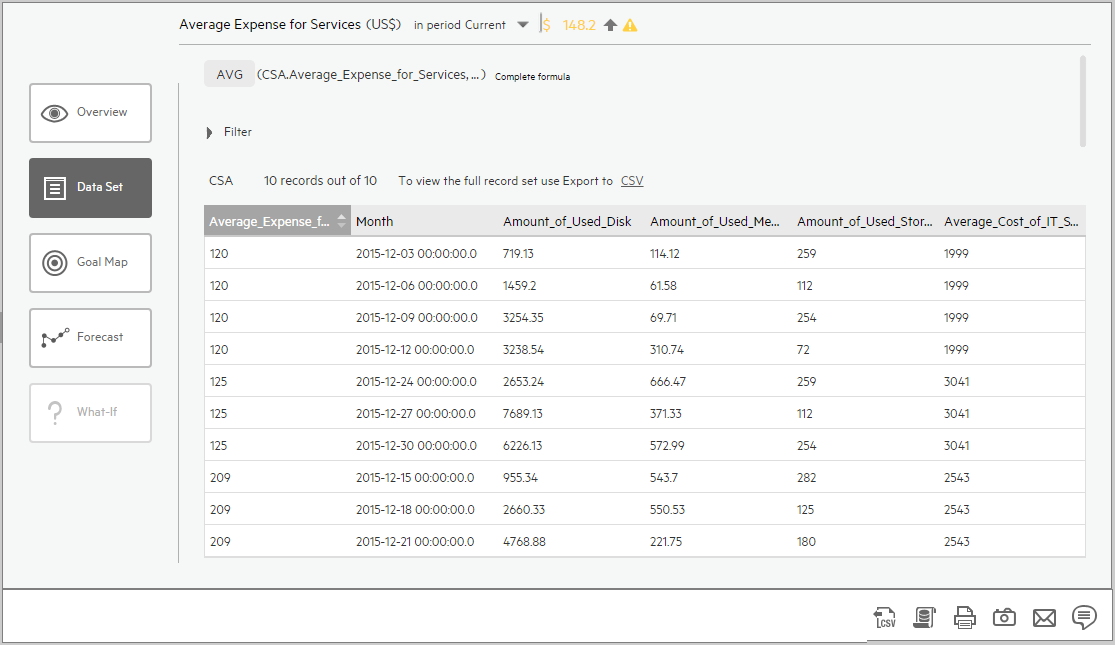
To view the complete list of raw data, click
 .
.
 View the SQL query details
View the SQL query details
To view the SQL phrase that is executed in the database and the relevant database connection details (DB server and DB schema):
-
Move the cursor over the relevant item in the KPI, Metric, or Scorecard component in the Dashboard page. In the tooltip that opens, click Explore.... The EXPLORER tab opens for the selected item.
Or click the Explorer tab to display the Active KPIs tree, and by clicking the relevant KPI, KPI Breakdown, Metric, Metric Breakdown, or Unassigned KPI in the tree, display detailed information about the selected item in the EXPLORER tab.
-
Click the Data Set button.
The formula used to calculate the KPI or Metric is displayed at the top of the page. The aggregation functions that appear in the formula have a colored background.
-
Click the relevant aggregation function and then click
 . A dialog box opens and displays the name of the machine on which the database is installed followed by the port used, the name of the Target schema, and the SQL query that is run to perform the calculation corresponding to the function currently highlighted in the formula.
. A dialog box opens and displays the name of the machine on which the database is installed followed by the port used, the name of the Target schema, and the SQL query that is run to perform the calculation corresponding to the function currently highlighted in the formula. 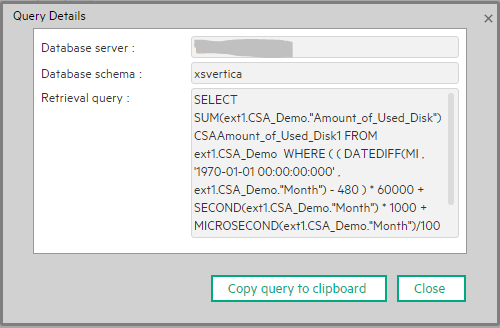
 Export raw data to a .csv file
Export raw data to a .csv file
To export the raw data to a .csv file:
-
Click the Explorer tab to display the Active KPIs tree, and by clicking the relevant Objective, KPI, KPI Breakdown, Metric, Metric Breakdown, or Unassigned KPI in the tree, display detailed information about the selected item in the EXPLORER tab.
-
Click the Data Set button.
The formula used to calculate the KPI or Metric is displayed at the top of the page. The aggregation functions that appear in the formula have a colored background.

-
Click
 (or link) to export all the data included in the Target database table (not just the data displayed in the GUI table) that is used to calculate the function that is currently highlighted in the formula to a file in .csv format. It opens your list of directories where you can select where to save the .csv file you are creating.
(or link) to export all the data included in the Target database table (not just the data displayed in the GUI table) that is used to calculate the function that is currently highlighted in the formula to a file in .csv format. It opens your list of directories where you can select where to save the .csv file you are creating.Depending on the settings of your browser, the file may be automatically saved to a predetermined download directory.
 View the key elements of the percentage formula
View the key elements of the percentage formula
To view a detailed description of the percentage formula:
-
Move the cursor over the relevant item in the KPI, Metric, or Scorecard component in the Dashboard page. In the tooltip that opens, click Explore.... The EXPLORER tab opens for the selected item.
Or click the Explorer tab to display the Active KPIs tree, and by clicking the relevant Objective, KPI, KPI Breakdown, Metric, Metric Breakdown, or Unassigned KPI in the tree, display detailed information about the selected item in the EXPLORER tab.
-
Click the Data Set button.
The formula used to calculate the KPI or Metric is displayed at the top of the page. The aggregation functions that appear in the formula have a colored background. The pie shows the information corresponding to the general section of the percentage formula and to all other data.
The filter describes the filter formula. For details, see Data Set.
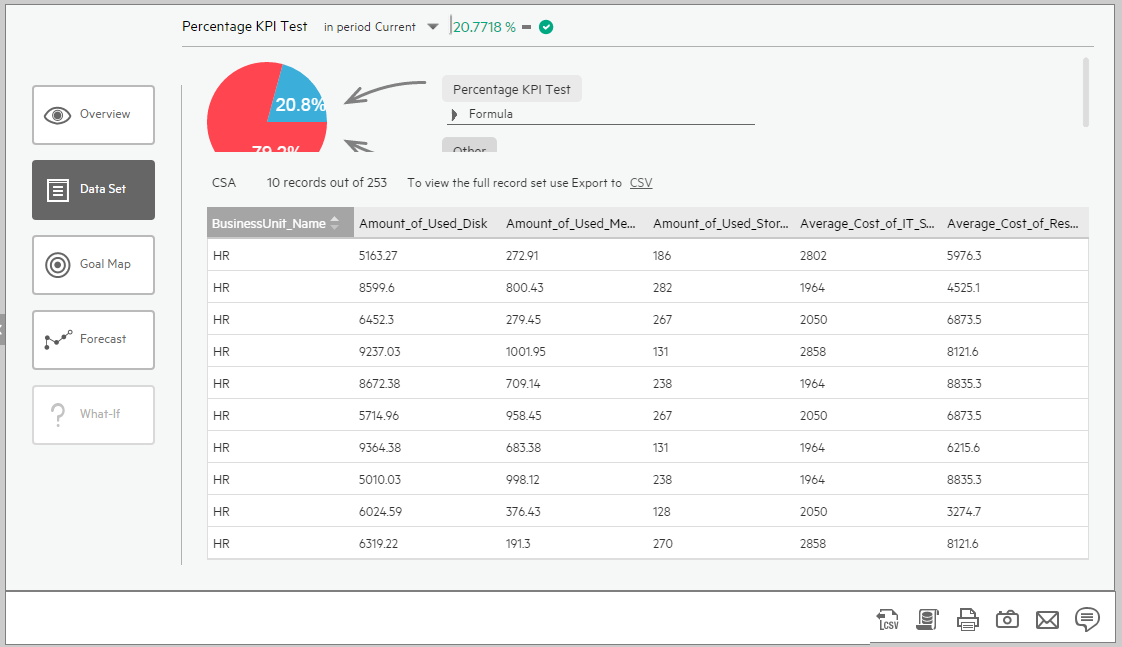
 Send the contents of the Data Set page by Email
Send the contents of the Data Set page by Email
- In the EXPLORER tab, click the relevant item in the Active KPIs tree and click Data Set.
-
To send an email to the Owner of the entity, click the Send Mail
 icon.
icon. If you send an email right after adding an annotation, the content of the annotation is automatically added to the email.
For additional details, see Explorer Tab - Data Set.
Movie: To display the relevant movie, open the ITBA application, click Help in the top right corner of the application main page and select the Movies option. Select the relevant movie. For details, see .
 Export the contents of the Data Set page to a PDF file
Export the contents of the Data Set page to a PDF file
- In the EXPLORER tab, click the relevant item in the Active KPIs tree and click Data Set.
- To export the contents of the Data Set page to a PDF file, click the Save snapshot
 icon.
icon.
For additional details, see Explorer Tab - Data Set.
Movie: To display the relevant movie, open the ITBA application, click Help in the top right corner of the application main page and select the Movies option. Select the relevant movie. For details, see .
 Print the contents of the Data Set page
Print the contents of the Data Set page
- In the EXPLORER tab, click the relevant item in the Active KPIs tree and click Data Set.
- To print the contents of the Data Set page, click the Print
 icon.
icon.
For additional details, see Explorer Tab - Data Set.
Movie: To display the relevant movie, open the ITBA application, click Help in the top right corner of the application main page and select the Movies option. Select the relevant movie. For details, see .
 Explorer Tab - Data Set
Explorer Tab - Data Set
Note When in IT Business Analytics, you navigate to another tab and then return to the Explorer tab, the details of the item that was previously in focus are displayed again. However, its properties might be refreshed.
The EXPLORER tab includes the following areas:

User interface elements are described below (when relevant, unlabeled elements are shown in angle brackets):
|
UI Element |
Description |
|---|---|
|
|
Enter the relevant string to display, in the tree, the nodes whose name includes the string. In addition, the child nodes of the filtered nodes are also listed even when the child node names do not include the string. If the display is filtered (in case you accessed the Explorer from one of the components in the Dashboard), the <Search> box displays information about the filter. For example:
|

|
Advanced Search. Opens additional fields to help you refine the component's filter:
|
| Active KPIs |
Depending on how you accessed the Explorer tab, the pane lists all the Scorecards, Perspectives, Objectives, KPIs, KPI Breakdowns, Metrics, Metric Breakdowns, and Unassigned KPIs, active in the IT Business Analytics or a subset of these items. The list of Scorecards that is displayed corresponds to the Scorecards that are permitted for your user. For details about permissions, see User Management Note A Scorecard Administrator who wants to see a newly created Scorecard in Explorer (and who has the correct permissions to see the Scorecard), needs to refresh the Explorer using the Refresh button to display the Scorecard. Click one of the Scorecards, Perspectives, Objectives, KPIs, KPI Breakdowns, Metrics, Metric Breakdowns, or Unassigned KPIs to display their detailed information in the other pane. The area also displays on the right side of the Active KPIs pane, a subset of the following items depending on the type of item you selected:
|

-
<Analysis area>
User interface elements are described below (when relevant, unlabeled elements are shown in angle brackets):
-
User interface elements are described below (when relevant, unlabeled elements are shown in angle brackets):
UI Element
Description

Send mail. Opens an Outlook email, with the name of the selected entity in the Subject box.

Save snapshot. Captures the current view in Explorer (all of it) in a new window. A dialog box opens to ask you where you want to save the image.

Print. Displays the Print dialog box where you can select the printer and how to print the content of the corresponding Explorer tab.
The printout includes:
- The contents of the area that was selected while you clicked the button.
- The Annotations Area.

Show/Hide Annotations. The button is enabled only for Objectives, KPIs, KPI Breakdowns, Metrics, Metric Breakdowns, or Unassigned KPI. It opens a box where you can add your annotation or hide them after viewing. For details, see Annotations.
Click the button again to close the Annotation area.
Note The Show/Hide Annotations icon with a little + sign
 in the bottom toolbar indicates that a new annotation was added to the selected item during the past week.
in the bottom toolbar indicates that a new annotation was added to the selected item during the past week.
The number of days during which the annotations are considered to be new is a setting that is configurable by your administrator in Admin > Scorecard > Dashboard Settings > Number of days annotations are considered new. For example, if the administrator gives the setting the value 14, then the + sign will indicate that the annotation was added in the last 2 weeks. The default is a week. -
User interface elements are described below (when relevant, unlabeled elements are shown in angle brackets):
UI Element
Description

Export to .csv. Click to export all the data included in the Target database table (not just the data displayed in the GUI table) that is used to calculate the function that is currently highlighted in the formula to a file in .csv format.
It opens your list of directories where you can select the location of the .CSV file you are creating. Depending on the settings of your browser, the file may be automatically saved to a predetermined download directory.

Display SQL. Click to show the SQL query that runs to calculate the function that is currently highlighted in the formula. It also displays the name of the database server and the name of the schema used by the SQL query.

Copy query to Clipboard. Click to copy the contents of Retrieval query to the clipboard.
We welcome your comments!
To open the configured email client on this computer, open an email window.
Otherwise, copy the information below to a web mail client, and send this email to SW-Doc@hpe.com.
Help Topic ID:
Product:
Topic Title:
Feedback:








 <Search>
<Search>
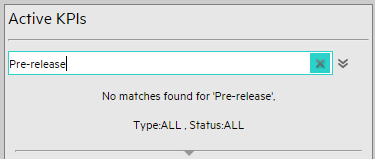
 The trend icon indicates the trend of the value calculated over the current period.
The trend icon indicates the trend of the value calculated over the current period. indicates that the status is Good.
indicates that the status is Good. indicates that the status is Warning.
indicates that the status is Warning. indicates that the status is Critical.
indicates that the status is Critical. indicates that the status is Pending and that the calculations have not yet been performed or completed.
indicates that the status is Pending and that the calculations have not yet been performed or completed.
 indicates that the status is Pending or No data, meaning that the calculation of the status was not yet completed or the status was not calculated or that there was en error in the calculation.
indicates that the status is Pending or No data, meaning that the calculation of the status was not yet completed or the status was not calculated or that there was en error in the calculation. 


 displayed in the filter indicates that the filter is for a KPI or a Metric.
displayed in the filter indicates that the filter is for a KPI or a Metric. displayed in the filter indicates that the filter is for a KPI Breakdown or a Metric Breakdown.
displayed in the filter indicates that the filter is for a KPI Breakdown or a Metric Breakdown.

